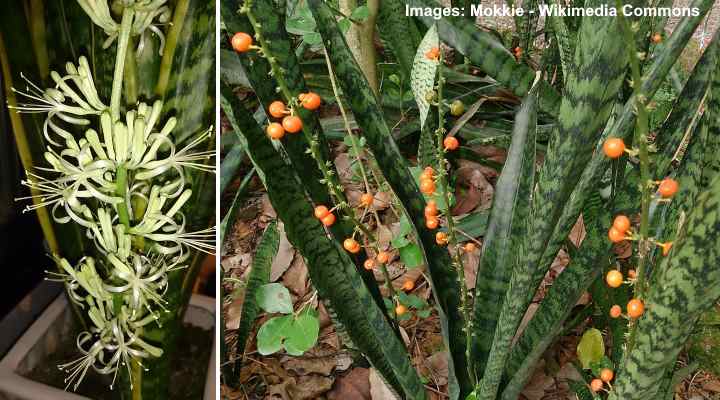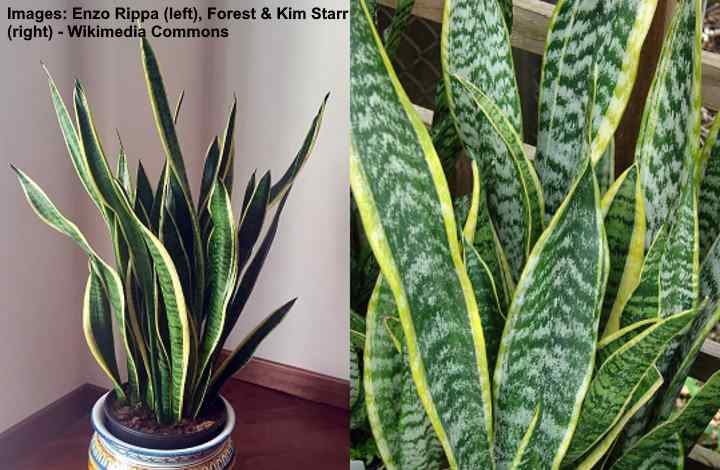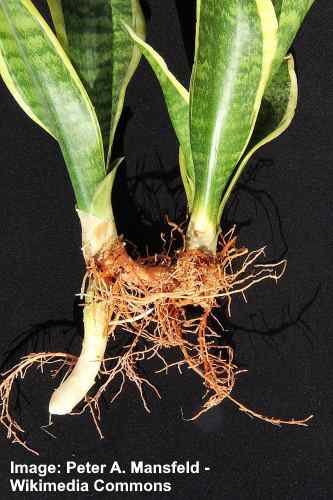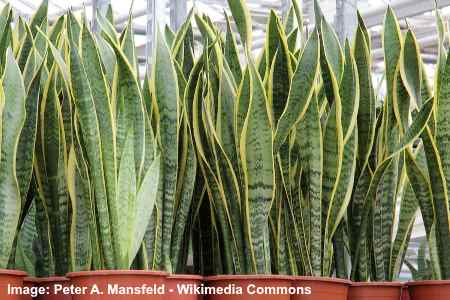Mother-in-Law’s Tongue (Snake Plant): Care and Growing Guide (Sansevieria Trifasciata)

The mother-in-law’s tongue, also called snake plant or Sansevieria Trifasciata, is a popular houseplant. This hardy indoor succulent plant can survive low light conditions, drought, and some neglect. The snake plant is identified by its long, upright sword-shaped green leaves with yellow margins.
How to care for a Sansevieria Trifasciata: The mother-in-law’s tongue thrives in most light conditions, growing in well-draining loamy soil, with average humidity. Water the snake plant occasionally when the soil is dry. Grow in temperatures between 70°F and 90°F (21°C – 32°C). Apply fertilizer once a month during the growing season.
Mother-in-law plants are a species of flowering Sansevieria plants, native to tropical countries in Africa.
The Mother-in-Law’s Tongue plant has long stiff leaves. These leaves grow vertically from the soil and can reach between 28” and 35” (70 – 90 cm) tall. Growing outdoors, the snake plant’s leaves can reach 6.5 ft. (2 m) tall. These long pointed leaves identify species of Sansevieria trifasciata.
Most of the snake plant cultivars have leaves that are dark green with grayish patterns and a bright yellow edge.
The botanical name for mother-in-law’s tongue is Sansevieria trifasciata. However, in 2017 botanists gave it the new name Dracaena trifasciata. Other common names for the plant include snake plant, viper’s bowstring hemp, and St. George’s sword. There are also many mother-in-law tongue cultivars.
This article is a care guide for the species Sansevieria trifasciata. At the end of the article, you’ll learn about some of the interesting cultivars in this tropical plant species.
Mother-in-Law’s Tongue Flowers

Sansevieria trifasciata white flowers (left) and orange fruits (right)
The Sansevieria trifasciata is a type of flowering plant. The plant blooms with long flower stalks covered in buds. When the buds blossom, they produce showy white or cream-colored flowers. The small clusters of lily-like white flowers create a pleasing scent. Mother-in-law’s tongue flowers in spring.
It’s rare for these Sansevieria species to flower indoors. Usually, mother-in-law’s tongue plants only flower under optimal conditions and when they’re slightly rootbound. If you are fortunate enough to see mother-in-law’s tongue flowering, the dainty whitish flowers turn into orange berries.
Benefits of Mother-in-Law’s Tongue Houseplant
According to NASA study, one of the benefits of mother-in-law’s tongue plant (Sansevieria) is filtering toxins from the air. The advantage of growing this type of snake plant is that it helps to removes airborne chemicals such as benzene, formaldehyde, xylene, and nitrogen oxide.
Because mother-in-law’s tongue can clean the air and grow in low light, it’s an ideal plant to keep in your bedroom.
Mother-in-Law’s Tongue Care Guide
Mother-in-law’s tongue is a hardy, low-maintenance houseplant that even appreciates some neglect. To care for this Sansevieria plant, keep it in partial shade or low light, water when the soil dries, and make sure the roots never get waterlogged. Proper plant care helps to make sure that it’s resistant to pests.
Let’s look in more detail at how to care for a mother-in-law’s tongue plant at home.
Light Requirements to Grow Mother-in-Law’s Tongue (Snake Plant) Indoors

Snake plant grows well in indirect light but can also tolerate low light conditions
Mother-in-law’s tongue plants aren’t fussy about light requirements. They thrive in bright light but protected from direct sunlight. Keeping the plant in a bright spot helps keep the variegation vibrant. Sansevieria plants also grow well in shade, partial shade, or dark corners of your house.
The most crucial care requirement when it comes to light is to keep mother-in-law’s tongue out of direct sunlight.
You may notice that keeping a mother-in-law’s tongue plant in dim lighting conditions affects its growth. All plants—Sansevierias included—need a certain amount of light to grow. Not getting enough light can result in dull leaf colors, weak growth, or foliage that looks thin.
If sunlight on the mother-in-law’s tongue plant is too intense, the leaves may become crispy and start to yellow. In these cases, you can adjust the light by moving the plant away from the window. Or, you could protect the Sansevieria from sunlight behind a sheer curtain.
The Best Type of Soil for Snake Plants
Mother-in-law’s tongue plants are a type of succulent, hence they prefer a loose potting soil mix that has excellent drainage. An ideal potting medium for growing Sansevieria plants at home is cactus potting soil. For a Sansevieria to grow well, the water should drain quickly out the bottom of the container. Avoid peat as this tends to retain too much moisture.
How to Water Mother-in-Law’s Tongue Houseplant

Water your snake plant only when the soil is mostly dry
Being a succulent, Sansevieria trifasciata plants only need occasional watering. Water the mother-in-law’s tongue only when the soil is mostly dry. To hydrate the plant, pour enough water in the snake plant pot until it drains from the drainage holes. Wait until the soil dries before watering again.
Rather than watering your snake plant on a schedule, check soil moisture regularly to see if the mother in law plant needs water.
Because mother-in-law’s tongue plants can survive some drought, it’s better to water less often than over-water. Over-watering a snake plant can cause root rot. You will know if you over-water your snake plant because the leaves will be yellow and mushy at the base.
The Right Temperature for Mother-in-Law’s Tongue
Sansevieria trifasciata thrive in average room temperatures. For best growth, don’t let the temperature indoors drop below 70°F (21°C). However, mother-in-law’s tongue plants are hardy to 50°F (10°C). You know if the temperature for your snake plant is right if you are warm enough and feel comfortable.
Although it’s difficult to kill a Sansevieria trifasciata, they don’t grow well in drafts. So, keep the plant away from air vents, open windows, or air-conditioner airflow. Also, in winter, make sure the snake plant pot is not beside a hot radiator, or it may start to wilt and have droopy leaves.
Mother-in-law’s tongue cultivars grow outdoors in USDA zone 10 to 12. As long as the temperature is above 55°F (12°C), the plant shouldn’t suffer any damage. But remember that they prefer warmer temperatures. If you take your potted snake plant outdoors in summer, put in a shady location with an average temperature of 70°F (21°C) or more.
Humidity Requirements for Mother-in-Law’s Tongue

Mother-in-Law’s Tongue grows well in an average room humidity
There is no need to mist a snake plant because average room humidity is excellent. As long as you water the Sansevieria properly, you don’t have to worry about humidity levels. To care for your plant, you could occasionally wipe the leaves with a damp cloth.
How to Fertilize Mother-in-Law’s Tongue and Other Snake Plants
Mother-in-law’s tongue plants are not heavy feeders because they grow slowly. During the growing season, apply fertilizer diluted to half strength. A balanced cactus fertilizer is ideal for providing the necessary nutrients for healthy growth. Feed the snake plant monthly in spring and summer and stop during wintertime.
Mother-in-Law’s Tongue Growth Rate
Mother-in-law’s tongue has a slow growth rate. Depending on the cultivar and growing conditions, Sansevieria trifasciata grows between one and three feet tall indoors. Snake plants that grow in bright locations tend to grow faster than those in shaded places.
On average, a mother-in-law’s tongue plant growing indoors will live for between five and ten years.
Mother-in-Law’s Tongue Propagation
It’s easy to propagate mother-in-law’s tongue plants. The easiest way to propagate the plants is to grow leaf cuttings in water. You can also use root division as a Sansevieria propagation method. Or, you can remove new shoots growing from the soil to grow a new mother-in-law’s tongue.
Let’s look in more detail at the various ways for propagating mother-in-law’s tongue plants.
How to propagate mother-in-law plant in water
To propagate Sansevieria trifasciata in water, place a cut leaf from a healthy mother-in-law plant in a jar of water that is one-quarter full. Put the jar in bright, indirect sunlight. Change the water every few days until roots appear at the base of the snake plant.
Once you have a rooted leaf cutting, plant it in an appropriate potting medium. Water thoroughly and put in bright light, protected from direct sunlight. Care for the new mother-in-law’s tongue plant as usual.
How to propagate mother-in-law’s tongue with cuttings
To propagate mother-in-law plant with cutting, cut a section of leaf from a healthy snake plant and place it in a moist potting mix or sand. The Sansevieria will root in a few weeks. Some people leave the cutting to dry for a couple of days until a callus forms at the cut end before placing it in the soil. This protects the cutting from bacterial infection.
How to propagate mother-in-law’s tongue from division

You can easily propagate Sansevieria trifasciata by cutting the rhizome
To propagate mother-in-law’s tongue plant from root division remove the snake plant from its container and shake off the dirt from the roots. Using sharp, sterile shears, cut the root (rhizome) into sections. Plant the new Sansevieria trifasciata plants in a pot with the appropriate potting soil.
When propagating mother-in-law’s tongue by the division method, make sure that each rhizome has at least one leaf in each section. This way, you help ensure that a healthy new Sansevieria trifasciata grows.
Repotting a Mother-in-Law’s Tongue (Snake Plant)
Sansevieria trifasciata plants rarely need repotting. Mother-in-law’s tongue is a slow-growing plant that prefers to be rootbound. One reason to repot a snake plant is if it becomes too tall and risks toppling over. Or if the root system fills the pot, you may need to repot it in a larger container.
If you notice signs of root rot, you will have to repot your mother-in-law’s tongue plant in fresh, sterile soil. When repotting, always check the roots for signs of disease—brown and mushy roots. Snip off any bad-looking roots.
Pruning Mother-in-law’s Tongue Plants
Snake plants rarely require pruning. The only reasons to prune a mother-in-law’s tongue are to control its size, remove dead or old leaves, or restore its shape.
To prune your snake plant, use a sterile sharp knife and cut the thick leaf at the base. This will allow new growth to grow to improve the appearance of your plant.
Pests Affecting Mother-in-law’s Tongue Growth
Mealybugs and spider mites are common houseplant pests that can infest snake plants. These pesky bugs feed on the plant’s juices and can affect its growth. You may notice that leaves become discolored. Usually, a solution of soapy water or neem oil are the best remedies for these destructive plant pests.
Spider mites usually thrive in dry conditions. Because mother-in-law’s tongue plants prefer dry soil, these tiny mites can be a real nuisance. Signs of spider mites are webbing on, or between the Sansevieria leaves. For the best advice on getting rid of these bugs, read this article on how to kill spider mites naturally.
Mealybugs are a type of scale insect that leave behind a white substance resembling cotton wool. These annoying bugs will damage your plant. You can find out in this article how to get rid of mealy bugs fast.
Related reading: how to get rid of houseplant pests naturally.
Diseases Affecting Mother-in-law’s Tongue Plants
Root rot affects mother-in-law’s tongue plants if you are over-watering them. Moisture-laden soil causes roots to decay, and fungal diseases can quickly take over your snake plant. The only way to resolve Sansevieria plant diseases is to replace the potting soil and remove the affected part of the plant.
Mother-in-law’s Tongue Toxicity
Sansevieria trifasciata plants are poisonous to cats and dogs. The toxic effects of ingesting mother-in-law’s tongue plants can cause nausea, vomiting, or diarrhea in pets.
Varieties of Mother-in-law’s Tongue (Sansevieria trifasciata)

Sansevieria trifasciata cultivars: ‘Futura Superba’ (left), ‘Futura Robusta’ (center) and ‘Black Gold’ (right)
There are several different kinds of Sansevieria trifasciata—each with its own characteristics. Here are a few interesting cultivars from the mother-in-law’s tongue plant species:
- Sansevieria Trifasciata ‘Black Gold’—growing to 3 ft. (1 m), this snake plant has stiff fibrous dark green leaves with a bright yellow edge. A smaller cultivar of this mother-in-law’s tongue is the ‘Futura Superba.’
- Sansevieria Trifasciata ‘Futura Robusta’—sword-shaped leaves with grayish-green striped patterns. Grows to just under 2 ft. (0.6 m) tall.
- Sansevieria Trifasciata ‘Golden Hahnii’—also called the ‘Bird’s Nest’ Sansevieria, the snake plant grows in a rosette pattern with short, stumpy leaves. The plant looks best when grown in clumps.

Sansevieria Trifasciata ‘Golden Hahnii’
- Sansevieria Trifasciata ‘Laurentii’—the tallest variety of mother-in-law’s tongue with long pointed leaves growing up to 4 ft. (1.2 m) tall. The green leaves have gray horizontal stripes and yellow margins.

Sansevieria Trifasciata ‘Laurentii’
- Sansevieria Trifasciata ‘Twisted Sister’—the curved and distorted leaves have a twisted look. Identify the Sansevieria by its yellow and lime variegation on short green pointed leaves.

Sansevieria Trifasciata ‘Twisted Sister’
Related: Amazing Types of Snake Plants (Sansevieria Varieties)
FAQs About Caring for Mother-in-law’s Tongue
Why does my Sansevieria mother-in-law’s tongue have droopy leaves?
Poor growing conditions usually cause snake plant leaves to go droopy. Over-watering causes root rot, which results in tops of the leaves beginning to flop over. To fix sagging snake leaves, only water the plant when the top 3” of soil is dry. When you water it—water it thoroughly.
Poor lighting can also cause a mother-in-law’s tongue to have a drooping look. Although this is a low-light type of plant, it can’t survive in complete darkness. So, if you’re watering the plant properly and its leaves are sagging, put the plant in a brighter location to revive it.
What do mushy leaves on a mother-in-law’s tongue mean?
Mushy leaves are a sign of overwatering mother in law plant. Sansevieria Trifasciata are succulent plants and will die if they sit in waterlogged soil. Overly-moist soil rots the roots, and the base of the leaves will become soft and mushy. To save a dying mother-in-law’s tongue plant, repot it in fresh, sterile potting soil.
Why are my mother-in-law’s tongue leaves turn brown?
Brown leaf tips are often a sign of over-watering a mother-in-law’s tongue plant. Once the leaves develop brown spots or brown tips, there’s nothing you can do. The best solution is to cut the entire leaf off to improve the plant’s appearance.
Why are my mother-in-law’s tongue leaves turn yellow?
Over-watering is the number one cause of yellowing Sansevieria leaves. If leaves start to turn yellow, hold off watering until at least 50 percent of the soil is dry. In many cases, your mother-in-law’s tongue will thank you for some neglect rather than fussing around it too much.
How do you know if Sansevieria is dying?
The signs of a dying mother-in-law’s tongue are yellow, drooping leaves that are mushy at the base. Unfortunately, these symptoms mean that root rot is already extensive. So, you need to act fast to stop your snake plant from dying. In the end, you may have to cut off the dead, soft foliage and roots to save the healthy part of the plant.
Related articles:
- Types of Snake Plants (Sansevieria Varieties)
- Drought Tolerant Plants That Need Very Little Water
- Indoor Plants That Don’t Need Sunlight
